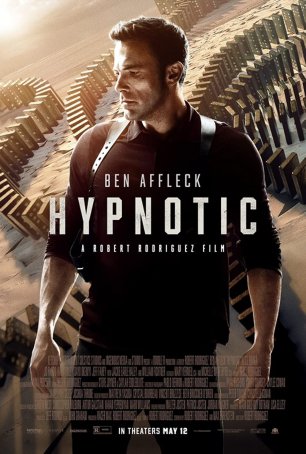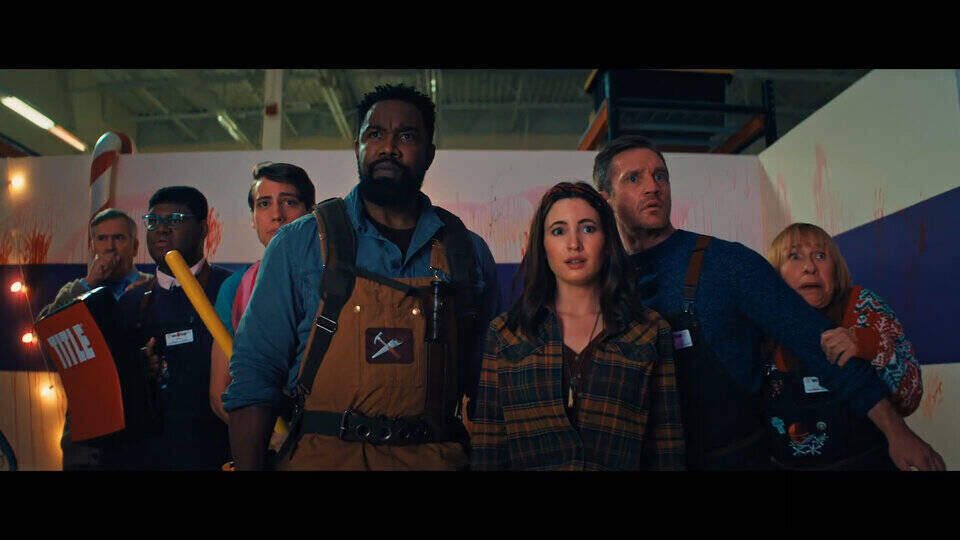Movie Reviews
Hypnotic | Reelviews Movie Reviews

This is what happens when a less-talented director tries to
make a Christopher Nolan movie. The convoluted result – low on thrills, lower
on coherence, and lowest on acting – is more confusing than compelling. Boiled
down to the essential details, there are some interesting ideas here, but the
manner in which they are developed is sloppy and haphazard. This feels like
something that director Robert Rodriguez slapped together while waiting to
learn whether a sequel to Battle Angel was going to be commissioned. The
casting of Ben Affleck in the lead, while giving him a “name” for the marquee,
was a bad choice from the beginning. Affleck is at his best playing
wisecracking supporting roles (like in the recent Air, which Affleck also
directed) and at his worst as an action hero. He sleepwalks his way through Hypnotic,
doing little to rouse the audience from its own slumber while failing to
generate any sparks with his co-star, Alice Braga.
Hypnotic introduces us to taciturn Austin police
detective Danny Rourke (Affleck), who is returning to work following of leave
of absence necessitated by the kidnapping (and presumed murder) of his
seven-year-old daughter. The crime, which occurred while Rourke was watching Minnie,
wrecked his marriage and left him groping for answers. The child’s body was
never found, putting him in a state of limbo, and he decrees that the only way
of staying sane is to get back to work.
His first case involves a bank robbery and, in the course of
the investigation, he learns about the existence of “hypnotics” – people with
Jedi-like mind powers who can create “constructs” in the minds of victims.
While in that state, they become pawns, sometimes unwittingly committing
crimes. After teaming up with a tarot card-reader/strip mall psychic, Diana
Cruz (Alice Braga), Danny discovers that he is at least partially immune to the
activities of hypnotics. He and Diana are soon on the trail of Lev Dell Rayne
(William Fichtner, whose career is littered with these kinds of characters),
the strongest and most dangerous of the hypnotics…and one who may be linked to
Minnie’s disappearance.
One of the problems with a story like this is that it’s
built into the premise that there are going to be mind-bending twists and
attacks on perceptions of reality. The challenge for a director is to make those
work narratively. Christopher Nolan has proven the ability to do this (most
notably in Inception, but also to a degree in some of his other films).
Rodriguez seems to be striving for a Nolan-esque approach but he misses the
target. From the beginning, his screenplay feels contrived. Nevertheless, to
keep viewers off-balance (and perhaps prevent them from thinking too hard),
Rodriguez pulls the rug out from under the audience on a fairly regular basis,
but the law of diminishing returns is in play. I can’t decide whether the
problem with Hypnotic is that it wasn’t given a running length necessary
to really explore the details of its world/culture or whether the inclusion of
low-energy action scenes dumbed down the rest of the project.
As it is, the movie is short enough that it doesn’t invite
boredom and Rodriguez can’t be accused of padding out the length to satisfy his
ego (something increasingly common in 21st century motion pictures).
But the end result lacks heft. Even once the underlying truth has been decoded,
the stakes never seem big enough and the threat posed by the hypnotics remains
fuzzy. There’s a sense that Rodriguez has a wider, deeper story to tell but
commercial necessities prevent that. The film’s likely box office failure –
it’s all-but-DOA due to minimal marketing and poor title recognition – will
doom the potential development of additional installments. In the end, all
we’ll be left with is Hypnotic and this single movie isn’t sufficiently
engaging to work as more than a throw-away addition to some streaming service’s
catalog.
Hypnotic (United States, 2023)

Movie Reviews
Andy Greskoviak’s ‘BLACK FRIDAY’ (2021) – Movie Review – PopHorror

Work-related horror often brings some of the best ambiance to the genre, as co-workers being trapped in a confined space ratchets up the internal clock and limits the options of the survivors. Such is the case in Black Friday, a horror comedy named after the newly formed “holiday.” As we get ready to sit down with our families and plan our shopping sprees, let’s line up to talk about the ups and downs of this film.
The characters in Black Friday are heavily stereotyped and modeled after longtime retail workers, so that anybody who works in that field will be immediately endeared to the self-deprecation and in-jokes that come with it. While archetypes like the unfeeling boss, the new deer-in-headlights, and the creepy older fraternizer are a little too ham-fisted, each of the actors have some nice moments and dry delivery that makes the comedy pop.

The toy store is well designed and well lit, so that the ambiance is not only set up for character isolation but also has a warm holiday feel and nostalgic props strewn about. This movie feels like a bit of Clerks mixed with Mayhem and The Fog. The comedy overtakes the horror in a bit of an unbalance, but when the movie chooses practical effects over CGI, the designs are gruesome and intricate.
When Black Friday leans into the heart and realism inside of its relationships, it really shines. This may be the kind of movie to click on after the turkey and pie start to kick in.
It’s available (as of this writing) on Freevee and Amazon Prime.
Movie Reviews
Movie Review: 'Moana 2' – Catholic Review

NEW YORK (OSV News) – The high-spirited Oceanaian princess who gave her name to a 2016 animated feature returns for further adventures in “Moana 2” (Disney).
Like its predecessor, the new arrival is free of the kind of content that usually restricts the appropriate audience for a film. But it also follows the original in incorporating notions at variance with a Judeo-Christian worldview, making it a doubtful choice for youngsters.
This time out, skilled navigator Moana (voice of Auli‘i Cravalho) aims to journey from her home island of Motunui to a long-lost, legendary isle called Motufetu. The rediscovery of Motufetu, we’re told, would enable all the inhabitants of the region to conquer the distances separating their various homelands and come together in unity.
Moana is once again aided on her quest by much-tattooed, shape-shifting demigod Maui (voice of Dwayne Johnson). Given that the crew she’s assembled for her expedition includes Pua, an affectionate but timorous pig, and Heihei, a twitchy, perpetually bewildered chicken, Moana may need all the help she can get.
Moana’s trio of human fellow travelers have their limitations as well. Thus Kele (voice of David Fane) is a gruff farmer prone to seasickness, Loto (voice of Rose Matafeo) is a hyper-creative but easily distracted ship designer while historian Moni (voice of Hualalai Chung), although highly knowledgeable about local lore, is also a naive fanboy for whom the thought of meeting his idol Maui is overwhelming.
Directed by co-writer Dana Ledoux Miller, Jason Hand and David G. Derrick Jr., this lively and eye-pleasing musical is family-friendly in most respects — some material that might frighten the youngest viewers notwithstanding. Yet Miller and Jared Bush’s screenplay is full of the same concepts derived from indigenous mythology that were prominent in the previous movie.
Moana, for instance, can communicate with the sea, which is here anthropomorphized sufficiently to give her the occasional high-five. And Moana’s deceased maternal grandmother, Tala (voice of Rachel House), is among the revered ancestors who appear to the now young-adult heroine, having taken on the post-mortem shape of a manta ray.
The parents of impressionable kids may be concerned by the degree to which these ideas depart from revealed truth. As for older teens, they’ll likely be proof against this aspect of the proceedings, especially if they’ve been well catechized.
The film contains potentially scary scenes of action and peril, nonscriptural religious ideas and practices as well as a few childish gross-out visuals. The OSV News classification is A-II — adults and adolescents. The Motion Picture Association rating is PG — parental guidance suggested. Some material may not be suitable for children.
Read More Movie & TV Reviews
Copyright © 2024 OSV News
Movie Reviews
Rhythm Of Dammam Review: An Exceptionally Evocative, Visually Arresting Film

New Delhi:
The Siddis, a community unrepresented in Indian cinema, is under the spotlight in Rhythm of Dammam, an exceptionally evocative, visually arresting film written and directed by Kerala-born, New York-based Jayan Cherian.
The film premiered this week at the 55th International Film Festival of India in Goa. It is now headed to the International Competition line-up of the upcoming 29th International Film Festival of Kerala.
Rhythm of Dammam – the title alludes to a musical tradition germane to the Siddi way of life – shines a light on the plight of the marginalised Afro-Indian tribe that languishes at the bottom of India’s social hierarchy.
In 2013, Cherian’s debut feature, Papilio Buddha, probed systemic and physical violence perpetrated against Dalits, women and the environment. Three years later, he made Ka Bodyscapes, a film about three rebellious millennials who defy notions of gender and sexuality perpetuated to a change-averse society.
Rhythm of Dammam isn’t quite as subversive but, like the filmmaker’s previous films, is political to the core. Using relatively muted means, it examines the marginalization of the Siddis who have suffered centuries of oppression.
Cherian’s script, which draws liberally from his extensive documentation of the lives of the forest dwellers, alludes tangentially yet unambiguously to the obliteration of the endangered minority’s history, culture and language.
Rhythm of Dammam, lit and lensed by Sabin Uralikandy, has the tone and texture of a documentary. However, the seeds of an ethnographic film embedded in the film are grafted upon a full-blown fictional structure for the purpose of elucidation. The strategy works wonderfully well.
The film’s protagonist, a 12-year-old Siddi boy, Jayaram (Chinmaya Siddi), struggles to come to terms with the demise of his grandfather Rama Bantu Siddi (Parashuram Siddi). His anguish, bewilderment and fears are aggravated by the ways in which the adults around him react to the death and its aftermath.
His alcoholic, debt-ridden father Bhaskara (Prashant Siddi, widely known to Kannada movie fans), bickers endlessly with his younger brother Ganapathi (Nagaraj Siddi). The two men have their eyes on what the deceased man is believed to have bequeathed to them.
Their home and the land on which it stands are in danger of being seized by the upper-caste landlord to whom Bhaskara owes a few thousand rupees. He hopes to avert the eventuality with the inherited money. But the box Bhaskara digs out of a corner of the house contains trinkets of little material worth.
To Jayaram, however, the heirloom, no matter how worthless, become a ready, if unsettling, conduit to the hoary roots of his brutally exploited tribe who were brought to India as slaves by Portuguese and Arab traders and thereafter left to deal with continuing subjugation and persecution over many centuries.
The principal actors in Rhythm of Dammam, set in Yellapur in the Uttara Kannada district of Karnataka, where a large percentage of Hindu Siddis are concentrated, are all non-actors from the community. The actors cast as non-tribals, all tertiary characters – the landlord, a doctor, or an instructor in a tribal boys’ hostel – are (or look like) real people.
Cherian sets the actors free to improvise their performances, songs and dances. Many extended shots with a static camera provide naturalistic, unmediated frames to create a tangible context for the sufferings of the Siddis even as Jayaram’s visions of his forebears transport the boy, and the audience, to a surreal, often disturbing, zone.
The assimilation of the Siddis we see in the film is complete, so, ironically, is their alienation from mainstream India. They speak a creole of Konkani, which is the language of their religious chants. Their gods and rituals are Hindu. But their spirit – embodied in the white-robed figure of the grandfather Jayaram sees and touches in his dreams/nightmares – is driven by a yearning for an identity.
Politics makes its emphatic way into Rhythm of Dammam. The songs and dances of the Siddis, performed to the accompaniment of the dual-headed cylinder drums called dammam, which also gives their principal musical tradition its name.
The dances are studiedly unchoreographed. The actors work themselves up into a frenzy and create their own moves once they get into the swing of the music. It is marked by a distinctly Afro accent.
Haunted by what his grandpa is trying to tell him, Jayaram turns febrile, teeters on the edge of delirium, and is branded a problem child in need of healing. A fretful mother, an aunt possessed by Goddess Yellamma, a community shaman and a doctor who prescribes psychiatric treatment suggest ways to help the boy tide over his problem.
Jayaram’s fragile state of mind reflects the reality of a community that dangles between a past they have all but forgotten and a present that they would rather put behind them.
A young man raps angrily, bemoaning the community’s loss of the soul, language and identity. The languages Jayaram speaks serve to denote how far removed the Siddis of India are from their Bantu roots.
In Jayaram’s school, the medium of instruction is Kannada. The teacher, a non-Siddi, makes the students recite a patriotic pledge before testing the students’ knowledge of the world’s seven continents. Jayaram is lost in thought.
The teacher ridicules him. He asks: Where do you live, Jayaram? Please, the boy replies. That is the name of his village. Jayaram’s ancestry, straddling two continents, is shrouded in a dense haze. For him, the assertion of specificity of location stems from a desire to belong.
When Jayaram is admitted to a hostel, the mass prayer there, rendered in Sanskrit, is overtly religious. Every step that he moves away from his moorings is indicative of the blows that his ancestors have faced.
Amid the politics that Rhythm of Dammam espouses, Cherian sprinkles the narrative with pure magic seen through the pristine eyes of a pre-teen boy. The tender, poetic imagery suggests a despairing search for stability amid a frightening absence of certitude.
Rhythm of Dammam trains its empathetic spotlight on the troubles of one community. But not only does the film give voice to the voiceless, it also speaks to all those who find themselves painted into a corner by history.
Hitting all the right notes, Rhythm of Dammam laments the undermining of a civilisational tapestry that thrives on diversity.
-

 Science1 week ago
Science1 week agoTrump nominates Dr. Oz to head Medicare and Medicaid and help take on 'illness industrial complex'
-

 Health7 days ago
Health7 days agoHoliday gatherings can lead to stress eating: Try these 5 tips to control it
-

 Science3 days ago
Science3 days agoDespite warnings from bird flu experts, it's business as usual in California dairy country
-

 Health4 days ago
Health4 days agoCheekyMD Offers Needle-Free GLP-1s | Woman's World
-

 Science1 week ago
Science1 week agoAlameda County child believed to be latest case of bird flu; source unknown
-

 Technology3 days ago
Technology3 days agoLost access? Here’s how to reclaim your Facebook account
-

 Sports1 week ago
Sports1 week agoBehind Comcast's big TV deal: a bleak picture for once mighty cable industry
-

 Entertainment2 days ago
Entertainment2 days agoReview: A tense household becomes a metaphor for Iran's divisions in 'The Seed of the Sacred Fig'


















